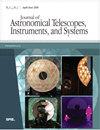Adjustable X-ray optics: thin-film actuator measurement and figure correction performance
IF 3.1
3区 工程技术
Q2 ENGINEERING, AEROSPACE
Journal of Astronomical Telescopes Instruments and Systems
Pub Date : 2024-08-01
DOI:10.1117/1.jatis.10.3.039003
引用次数: 0
Abstract
Several proposed future X-ray missions will require thin (≤0.5 mm thick) mirrors with precise surface figures to maintain high angular resolution (≤0.5 arcsec). To study methods of meeting these requirements, adjustable X-ray optics have been fabricated with thin-film piezoelectric actuators to perform figure correction. The fabrication and actuator performance for an adjustable X-ray mirror that forms a conical approximation to a Wolter-I telescope are reported. The individual responses of actuator cells were measured and shown to induce a figure change of 870 nm peak-to-valley on average. These measured responses were compared with predicted responses generated using a finite-element analysis algorithm. On average, the measured and predicted cell responses agreed to within 60 nm root mean square. A set of representative mirror distortions and the measured cell responses were used to simulate figure corrections and calculate the half-power diameter (HPD, single reflection at 1 keV) achieved. These simulations showed an improvement in 4.5 to 9 arcsec mirrors to 0.5 to 1.5 arcsec HPD. The disagreements between the predicted and measured cells’ performance in actuation and figure correction were attributed to a high spatial frequency metrology error and differences in mirror bonding considerations between the finite-element analysis model and the as-built mirror mount.可调式 X 射线光学元件:薄膜致动器的测量和图形校正性能
一些拟议的未来 X 射线任务将需要具有精确表面数字的薄型(≤0.5 毫米厚)反射镜,以保持高角度分辨率(≤0.5 弧秒)。为了研究满足这些要求的方法,我们用薄膜压电致动器制造了可调 X 射线光学镜,以进行图形校正。本报告介绍了可调节 X 射线反射镜的制造和致动器性能,该反射镜可形成近似于 Wolter-I 望远镜的锥形。对致动器单元的单个响应进行了测量,结果表明平均可引起 870 nm 波峰-波谷的图形变化。这些测量响应与使用有限元分析算法生成的预测响应进行了比较。平均而言,测量和预测的单元响应在 60 nm 均方根以内。一组有代表性的镜面变形和测量的电池响应被用来模拟数字校正,并计算所实现的半功率直径(HPD,1 千伏时的单次反射)。模拟结果表明,4.5 至 9 弧秒镜面的 HPD 值提高到了 0.5 至 1.5 弧秒。在致动和图形校正方面,预测和测量单元性能之间的差异归因于高空间频率计量误差,以及有限元分析模型和实际安装的反射镜之间在反射镜粘接考虑方面的差异。
本文章由计算机程序翻译,如有差异,请以英文原文为准。
求助全文
约1分钟内获得全文
求助全文
来源期刊

Journal of Astronomical Telescopes Instruments and Systems
Engineering-Mechanical Engineering
CiteScore
4.40
自引率
13.00%
发文量
119
期刊介绍:
The Journal of Astronomical Telescopes, Instruments, and Systems publishes peer-reviewed papers reporting on original research in the development, testing, and application of telescopes, instrumentation, techniques, and systems for ground- and space-based astronomy.
 求助内容:
求助内容: 应助结果提醒方式:
应助结果提醒方式:


